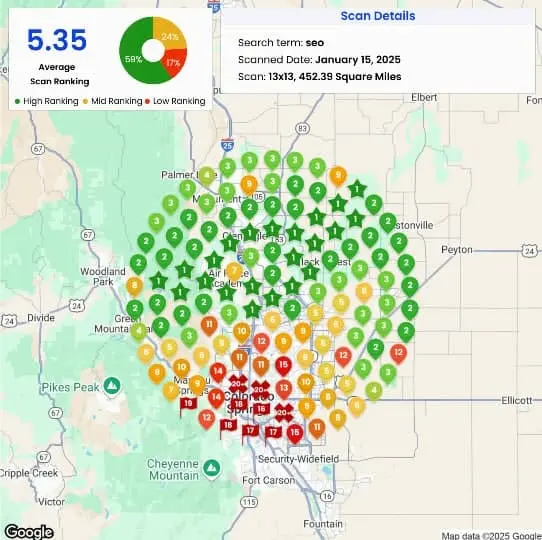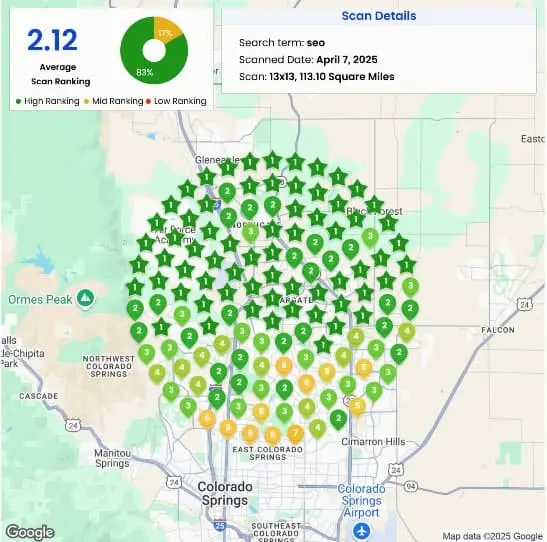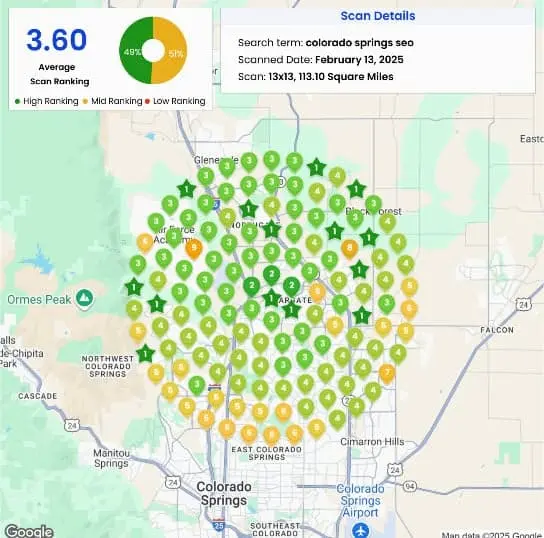
Colorado businesses face unique local search challenges - from competitive Front Range markets to seasonal mountain communities. We understand these dynamics and deliver results across all Colorado markets.
We apply the same proven local SEO strategies to our clients' businesses that have earned us top rankings across Colorado's most competitive SEO markets.
Most agencies focus on just one aspect of local search. We understand that true market dominance requires optimizing your entire digital presence across all Colorado markets.
While other agencies spread their efforts thin across too many tactics, we specialize exclusively in local SEO optimization with deep Colorado market knowledge.
This comprehensive approach ensures your Colorado business dominates local search results and attracts customers from your exact service areas.
Get BOTH comprehensive Local SEO AND Google Maps Optimization for one low price. While other agencies charge separately for these services, we include both strategies in every plan.
Get BOTH comprehensive Local SEO AND Google Maps Optimization for one low price. While other agencies charge separately for these services, we include both strategies in every plan because they work best together.
Local SEO + Google Maps Optimization = Complete Market Dominance
See Our Plans







All scans were conducted during business hours
These results demonstrate our consistent top rankings across multiple competitive Colorado SEO keywords, proving the effectiveness of our comprehensive local search strategies.
Our Colorado local SEO agency offers customized plans based on your specific market targeting needs:
Complete local search optimization focused on improving your local map pack rankings, Google Business Profile optimization, and 'near me' search visibility.
Includes:
Google Business Profile optimization & ongoing management
Local keyword research & 'near me' search targeting
Basic local citation building & NAP consistency
Mobile-first website optimization review
Monthly local ranking reports & analytics
Review management system setup
/month
BUYPerfect for: Single-location businesses in low to medium competition markets looking to improve local search visibility and attract more 'near me' searches.
Minimal website updates will be done.
Comprehensive local search domination for multi-location businesses including advanced Google Business Profile optimization, local landing page creation, and competitive local market targeting.
Includes: Everything in Basic Plan
2-3 location optimization with individual local landing pages
Advanced local citation building campaign
Schema markup & structured data implementation
Voice search optimization strategies
Hyperlocal content creation
Competitive local SEO analysis
/month
BUYPerfect for: Multi-location businesses or single locations in competitive markets needing comprehensive local search visibility.
Minimal website updates will be done.
Enterprise-level local SEO with maximum locations coverage, advanced technical implementation, and aggressive local market domination strategies.
Includes: Everything in Advanced Plan
3-5 location optimization with full local landing page suite
Advanced schema markup & technical SEO implementation
Local link building & community outreach
AI-powered local search optimization
Priority support & monthly strategy consultations
Advanced local analytics & reporting dashboard
/month
BUYPerfect for: Enterprise businesses, franchises, or highly competitive local markets requiring maximum local search visibility and market share capture.
Minimal website updates will be done.
Discover how your Colorado business ranks against local competitors with our comprehensive local SEO analysis. Our specialists will evaluate your Google Business Profile, local citations, and competitive landscape across Colorado markets.
Complete the form below for your FREE Custom Local SEO Audit from Colorado's top-rated local search agency.
(Requires an active Google Business Profile for complete analysis)
Local SEO is a specialized strategy focused on optimizing your online presence to attract more customers from relevant local searches in Colorado. It's crucial for businesses that serve specific geographic areas because it helps you appear in Google Maps, local pack results, and localized organic search results. Unlike general SEO, local SEO targets customers in your Colorado service area who are actively looking for your products or services, making these leads more valuable and likely to convert.
We optimize for Colorado markets by understanding the unique characteristics of each region. For Denver, we focus on competitive metro strategies; for Colorado Springs, we target military and tourism communities; for Pueblo, we emphasize local community connections. Our approach includes location-specific keyword targeting, local citation building in Colorado directories, and content that speaks to each market's unique demographics and search patterns.
NAP stands for Name, Address, and Phone number. NAP consistency means ensuring your business information appears exactly the same across all online directories, your website, and your Google Business Profile. This is especially important for Colorado businesses because inconsistent NAP information confuses search engines and can hurt your local rankings significantly. Our local SEO process includes thorough NAP auditing and correction across all Colorado business directories and national platforms.
Local map pack optimization involves a combination of Google Business Profile optimization, local citation building, review management, proximity factors, and ensuring your business appears in the top 3 local results for relevant searches in your Colorado market. We adapt our strategies based on the competitiveness of each Colorado market - Denver requires more aggressive tactics than smaller Colorado towns, while tourist areas like Aspen need seasonal optimization strategies.
Yes, while we're Colorado-based and have deep expertise in Colorado markets, we provide local SEO services to businesses throughout the United States. Our strategies are adaptable to the unique characteristics of different local markets, allowing us to deliver results regardless of your location. We currently work with clients nationwide while maintaining our Colorado market specialization.
Results vary based on your Colorado market's competitiveness and starting point, but most businesses see measurable improvements in Google Maps and local organic rankings within 30-60 days. Colorado Springs and Denver are more competitive markets that may take 3-6 months for significant results, while smaller Colorado towns often see faster improvements. We provide regular reporting on your key metrics like rankings, visibility, calls, and conversions across your specific Colorado service areas.
Unlike most SEO companies that spread their efforts across dozens of tactics with minimal impact, we specialize exclusively in local search optimization with deep Colorado market knowledge. We understand the unique characteristics of Colorado markets - from military communities in Colorado Springs to competitive tech markets in Denver to tourism-focused areas like Aspen. Our approach is results-driven, focusing on metrics that matter for Colorado businesses rather than vanity metrics that don't impact your bottom line.
Our local SEO services start at $999 per month for our Basic Local Plan, which is ideal for single-location Colorado businesses. We also offer more comprehensive local SEO plans for businesses with multiple Colorado locations or those in highly competitive markets like Denver. Each plan is customized based on your specific Colorado market goals, competitiveness, and local conditions. We believe in transparent pricing and delivering clear ROI for our Colorado local SEO clients.
Results can vary based on your Colorado market's competitiveness and starting point, but most businesses see measurable improvements in Google Maps and local organic rankings within 30-60 days. Significant increases in local leads and sales typically occur in the 3-6 month timeframe as your local SEO optimizations compound. Highly competitive Colorado markets like Denver may require 6-12 months of consistent effort, but we provide regular reporting on your key metrics like rankings, visibility, calls, and conversions across your Colorado service areas.
Yes, we have experience optimizing for Colorado mountain communities and resort areas like Aspen, Vail, Steamboat Springs, and Breckenridge. These markets require specialized strategies including seasonal optimization, tourist vs. local targeting, and understanding the unique search patterns of visitors to Colorado's mountain regions. We adapt our local SEO strategies to account for seasonal traffic fluctuations and tourism-driven search behaviors.
Coming Soon
